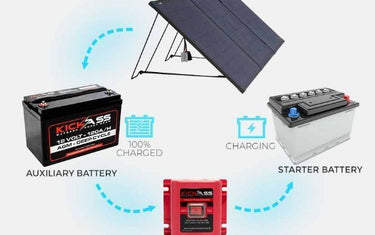Battery isolators, like KickAss Voltage Sensitive Relays (VSRs) and Low Voltage Disconnects (LVDs), are essential for managing power in off-grid and dual battery setups. These devices ensure your primary battery remains charged and ready to go while preventing the secondary battery from draining it, a crucial function for campers, 4WD enthusiasts, and anyone living off the grid.
What Are VSRs and How Do They Work?
A Voltage Sensitive Relay (VSR) is an automatic switch that connects and disconnects your starter and auxiliary batteries based on voltage levels. When the engine runs, and your alternator charges the batteries, the VSR detects the rising voltage and connects the batteries to allow charging. When the engine stops, and voltage drops, the VSR disconnects the batteries, preventing the starter battery from being drained by your accessories.
KickAss VSRs are built with dual-sensing capabilities, meaning they can detect voltage from both batteries, allowing charging to flow in either direction. This feature ensures that both batteries can receive charge, whether from the alternator, solar panels, or other sources, optimising power distribution and keeping your off-grid setup running smoothly.
What Are LVDs and How Do They Work?
Low Voltage Disconnects (LVDs) act as protectors for your battery system. They monitor your battery voltage and disconnect the load when it drops below a certain threshold, preventing deep discharge and prolonging battery life. For example, if you’re running lights, fridges, or other gear off your secondary battery, an LVD will cut off the power before the battery voltage gets critically low, safeguarding your battery from damage.
KickAss LVDs are designed for simplicity and reliability, automatically reconnecting the load when the voltage recovers, ensuring your equipment stays protected without the hassle of manual resets.
Why You Need Them
1. Protection for Your Starter Battery: VSRs keep your starter battery isolated when your vehicle is off, ensuring it remains fully charged for when you need to start your engine.
2. Prolong Battery Life: LVDs prevent your batteries from being overly discharged, extending their lifespan and reducing the need for costly replacements.
3. Efficient Power Management: With VSRs, you can automatically manage the charge between your starter and auxiliary batteries without manual intervention, making your setup more efficient and hassle-free.
4. Flexibility in Off-Grid Power: Whether you’re charging from your vehicle, solar, or other sources, these isolators ensure that power is distributed effectively and safely.
Choosing the Right Isolator
Selecting the right isolator depends on your specific needs and setup. KickAss offers a range of VSRs and LVDs that cater to various amperages and system requirements. The KickAss 12V Smart Battery Guard even combines VSR and LVD functionalities in one, providing a versatile solution for any off-grid power system.
For those looking to maximise their off-grid adventures, understanding and utilising VSRs and LVDs can make a world of difference. They not only protect your investment but also enhance your experience by ensuring a reliable and efficient power supply wherever your adventures take you. Explore KickAss VSRs and LVDs to find the perfect fit for your setup.

































































































